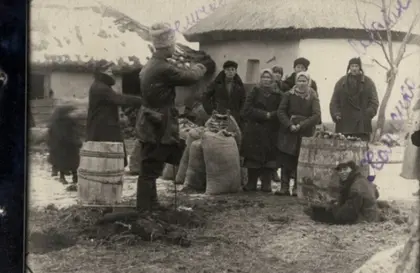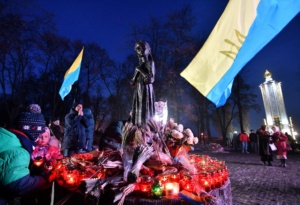Despite being ravaged by war and Russian aggression, the people of Ukraine will commemorate the 90th anniversary of the Holodomor genocide this year on Saturday, Nov. 26.
The Holodomor was a man-made disaster, the result of the brutal dictatorship of Joseph Stalin and his Soviet government. It resulted in the widespread starvation of millions in Soviet Russia’s grain-growing territories in 1932 and 1933.
A yearly national remembrance day honouring the victims of the Holodomor was established on the fourth Saturday of November by a decree issued by Ukrainian President Leonid Kuchma in 1998.
Each year, when Ukrainians reflect on the Holodomor genocide, they remember millions of their ancestors—many of whom were just children—who died from starvation in Ukraine.
The genocide occurred before the Holocaust, and it is no secret that Ukraine continues to be traumatized by it even now. The tragedy left a deep scar on the country — making it just one aspect of Ukraine’s tumultuous relationship with Russia.
This year, Ukrainians will continue to look back on their history and acknowledge a terrifying recurring theme: Russian brutality and terror which persists nearly a century later.
What was the Holodomor genocide, and when did it take place?
Millions of Ukrainian citizens perished in the Holodomor genocide, an artificial, man-made famine that the Soviet Union under Joseph Stalin orchestrated 90 years ago in 1932-1933. Many of those who survived the Holodomor were farming families, ordinary everyday people and members of farming communities.
In most studies that have analysed the atrocity, the number of Ukrainians who died during the Holodomor is estimated to have ranged between 3.5 million and 7 million. Historical sources indicate that at its peak in the summer of 1933, an estimated 28,000 Ukrainians were dying of starvation every single day.
While this was happening, the Soviet Union, exported 4.27 million tonnes of grain from Ukraine to earn hard currency for its industrialization drive – enough to nourish at least 12 million people for an entire year.
Given there was more than enough food to feed all the people in Ukraine, you might be wondering how and why the genocide occurred.
One of the reasons for carrying out this horrifying act was to stifle Ukrainian resistance movements, particularly those opposed rule from Moscow and sought to establish an independent Ukrainian state.
The Ukrainian language and culture have traditionally been strongly linked to villages and rural life, yet another reason why Stalin’s regime targeted these areas for mass famine.
The Soviet Foreign Minister Maxim Litvinov went as far as to publicly refute the existence of famine in 1933 and despite offers of assistance from the Red Cross and other humanitarian organisations, the Soviet leadership rejected them and stuck to their line denying anything untoward was taking place.
To this day, Moscow rejects the idea it was a genocide, placing the events in the broader context of famines that devastated regions of Central Asia and Russia at the time.
How did the Holodomor actually take place?
The famine was directly caused by a 1929 decision by Stalin to collectivize agriculture. Communist Party provocateurs who supported Stalin’s ideology and vision, evicted those farmers who were in outright opposition to collectivization and forced Ukrainians to abandon their land, private possessions, and other assets to the new collective farms.
This collectivization led to mass instability in the form of lower output and food shortages. It also sparked a series of urban unrests, such as armed uprisings in various parts of the country.
During the Holodomor, Ukrainians had a clear choice — to follow communist ideology or die.
The regime led by dictator Joseph Stalin, and supported by a whole army of dedicated communist agitators, made escape out of the crisis for Ukrainians impossible.
To make matters worse, Ukrainians risked provoking the government if they revealed their true identities by speaking Ukrainian or exhibiting their culture.
Accepting one’s Ukrainian identity implied accepting one’s status, imposed ruthlessly by Soviet ideology and thinking, as a subhuman villager who was incapable of contributing to society in the eyes of the Soviet state, or even accepting the risk that one must face death.
Accounts of extreme distress on the part of Ukrainian farmers, together with cases of anarchy, robbery, executions, and extreme hunger, are to be found in historic Soviet police files.
As you read this, you may have noticed something familiar: acts of violence and oppression, similar to those taking place in Ukraine right now in 2022, which seek to eradicate contemporary Ukraine and its identity as a sovereign state by murdering and torturing the local population.
The impact of genocide on Ukrainian national identity
Since people starved in the villages, where the majority of Ukrainians lived, cities ended up being the only locations where they could flee this living horror. The expansion of factories and other large-scale industrial facilities in urban areas also meant that more people could find work and earn enough money to survive.
These urban areas also evolved into hubs, where it was easier to try to brainwash Ukrainians into becoming the archetypal Soviet citizen.
During this period, the advancement of a solely Soviet identity and authoritative force exerted on Ukrainian citizens to speak the Russian language also increased. This made an indelible imprint on Ukraine and its history.
Collectivisation was, according to Soviet propaganda, the catalyst for the state’s progress, and the final goal was clear: to solidify Russian nationalism and allegiance at the heart of the Soviet empire.
How genocide shaped Ukrainian history
Today Ukraine has a museum dedicated to the victims of the Holodomor.
The National Museum of the Holodomor-Genocide is a state research, cultural, and educational organization. This weekend it will commemorate the anniversary of genocidal acts committed against the Ukrainian people in 1932–1933.
Are there parallels to today?
The current conflict has fuelled fears that history may repeat itself, with Russia’s targeting of grain storage facilities and its blockade of Ukraine’s Black Sea exports have sparked accusations that Moscow is again using food as a weapon of war.
When announcing his country is to officially declare the Holodomor a genocide next week, Robin Wagener of Germany’s Green party, said Putin is operating “in the cruel and criminal tradition of Stalin”.
“Once more, the basis for life in Ukraine is meant to be taken away through violence and terror, and the entire country brought to heel,” he told the daily Frankfurter Allgemeine Zeitung.
Global reaction
The 90th anniversary of the Holodomor has sparked reaction from all over the world.
In a statement released on Wednesday, Nov. 22, President Joe Biden said: .
“This November marks the anniversary of the Holodomor —’death by hunger.’ During his regime, Joseph Stalin imposed harsh and repressive policies on Ukraine, including creating a deliberate famine in 1932-33 that caused millions of innocent Ukrainian women, men, and children to perish.”
Pope Francis also paid tribute to the 90th anniversary, and drew parallels between the suffering that Ukrainians are currently going through and that which they endured during the genocide.
He issued additional requests for devotions for “terrible suffering of the dear and martyred Ukrainian people.”
“Saturday begins the anniversary of the terrible genocide of the Holodomor, the extermination by starvation artificially caused by Stalin between 1932-1933,” Pope Francis said. “Let us pray for the victims of this genocide and let us pray for so many Ukrainians — children, women, elderly, babies — who today are suffering the martyrdom of aggression.”
Speaking at the Holodomor Remembrance Prayer Service earlier this week at St. Patrick’s Cathedral in New York, U.S. Public Delegate Andrew Weinstein of the United States to the General Assembly of the United Nations, said this year’s commemoration is especially meaningful, as it “is set against the backdrop of yet another tragedy against the Ukrainian people.”
The Netherland’s deputy prime minister, Wopke Hoekstra, also honoured the Holodomor Genocide victims on Twitter on November 16:
“Russia’s use of food as a tool of war against Ukraine echoes the horror of the Holodomor. This man-made famine in 1932-’33 by the regime of Stalin led to the death of millions of Ukrainians. Yesterday we paused to reflect on this terrible event in history at the @HolodomorMuseum.”
Only 16 nations, including the U.S. and the Vatican, have to date proclaimed the Holodomor to be a genocide but this week Germany said it is also to declare the 1930s starvation of millions in Ukraine under Joseph Stalin a “genocide”, adopting language used by Kyiv, according to a draft text seen by AFP on Friday.
You can also highlight the text and press Ctrl + Enter





